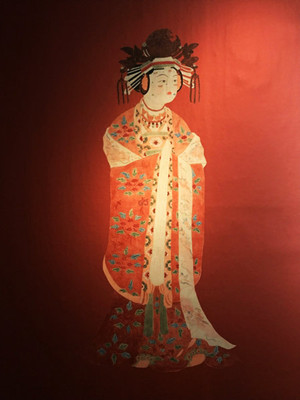
A piece of Chang Shana's work. (Photo provided to China Daily)
Chang Shana made her debut as a painter in 1945, at age 14, when she held a joint exhibition with her father, Chang Shuhong (1904-94), hailed as the "patron saint of Dunhuang", in Lanzhou, in northwestern Gansu province.
They were showcasing dozens of colorful ink-on-paper copies of the murals in the Mogao Grottoes. The exhibition caused a sensation leading to more attention being paid to the protection of the Dunhuang cave art.
Chang Shana was born in Lyon and lived in France till she was 6. Her parents were first-generation Chinese artists studying in France.
However, in 1943, the family moved to Dunhuang, a remote county in Gansu, because Chang Shuhong-by then a promising artist who had won several medals at salons in France-was inspired after reading about Dunhuang's Buddhist manuscripts and cave art in France.
In 1944, he became the founding director of the Dunhuang Art Institute (now the Dunhuang Academy). He gave up the prospect of furthering his art career and devoted himself to the protection and study of Dunhuang's treasures.
Chang Shana lived in Dunhuang for nearly six years before she was sent to the School of the Museum of Fine Arts in Boston, in the United States. In Dunhuang, where she leaned the basics of painting, she made facsimiles of the murals, under the guidance of her father, researchers at the institute and visiting artists.
Copies of her works are now on show at her solo exhibition, Everlasting Beauty of Dunhuang, at Beijing's National Art Museum of China.
These paintings show deities and sutras-a testimony to Dunhuang's past glories as a major stop on the ancient Silk Road.
Also, they encapsulate the memories of a teenage girl in Dunhuang, where she had to cope with harsh living conditions and her parents' divorce.
Liu Dawei, the chairman of the China Artists Association, remembers how difficult life in Dunhuang was in the late 1970s.
Liu, then a postgraduate of Chinese painting at the Central Academy of Fine Arts, traveled there with classmates to study the murals.
He says that during their stay, they were given lectures by Chang Shuhong at his home-a mud courtyard close to a dry riverbed in the vast desert-and they ate thick pancakes and pickled watermelon peel, which Chang said was what the institute staff had survived on for many years.
While attending school and taking care of her younger brother, Chang Shana found great comfort and strength in painting.
She says that she spent her school holidays painting in the grottoes. In the day, she climbed the ladders and followed researchers into the caves. At night, she learned sketching.
She says she felt excited to enter the caves, which did not have doors. As the caves faced the east, sunlight would illuminate the colorful paintings on the walls.
"All day long, I was surrounded by beautiful Buddhist figures who looked so benign. Above my head were the caisson ceilings on which sophisticated patterns were arranged. And, what surrounded me were vivid sutra paintings.
"I used to feel so enthralled by the colors and details that I sang as I painted."


















































